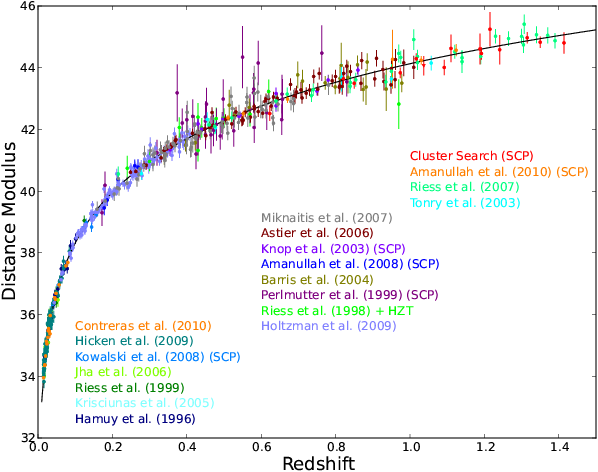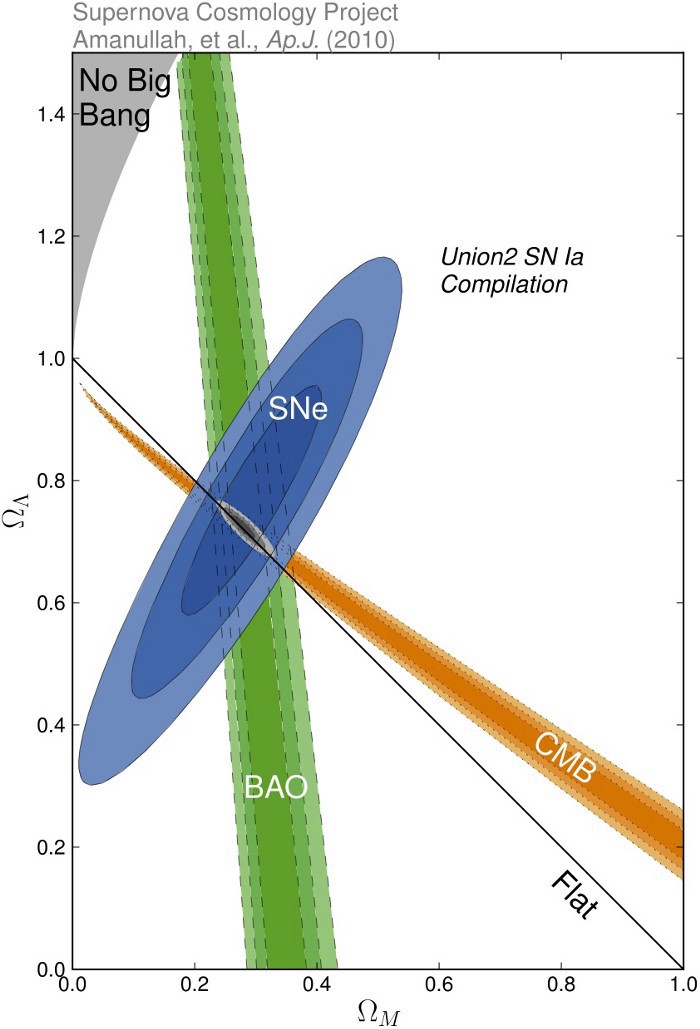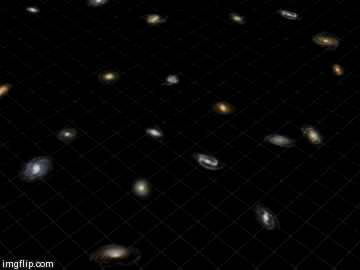Ask Ethan # 59: What is dark energy?
- Transfer
The universe, of course, is expanding, and this expansion is accelerating. But what do we know about this process besides the simple name “dark energy”?
Choosing between despair and energy, I will choose the last
- John Keats
All week you strained your brain trying to ask a deep and mysterious question about the Universe, and we received a lot of great questions - it's a pity that I can choose only one of them. This week, the honor goes to Piush Gupta, who asks:
We have learned that dark energy is about 70% of the energy of the Universe. We have evidence of its existence through various observations. And it really affects the evolution of the universe. But what is dark energy? Do we have any idea? Are there any suitable models for her?
And we really have a couple of good ideas, but let's check our knowledge first.

The first thing to accept is the concept of space-time, as well as the most important idea of the general theory of relativity: the amount and type of matter and energy in the Universe are inextricably linked with the evolution of space-time as the Universe moves in time. Before Einstein, it was believed that space and time are constant and fixed. On the one hand, there is a space that can be represented as a static three-dimensional grid, and on the other, time, a separate fixed continuum through which all points of space move simultaneously.
In GR, all this changes at once in two ways - and both are very important.

Firstly, space and time cannot be separated from each other. All objects move through space-time relative to each other. It is from the idea that not only your position in space and time is important, but also your speed, that is, movement through space and time, the name of the theory of relativity follows. If you and I are at the same point in space-time, but you are moving relative to me with considerable speed, then we move not only through space, but also through time. It is from here that the idea arises that the clocks go at different speeds for observers from different reference systems, as well as the twin paradox.
Therefore, space and time are not absolute and independent of each other. All objects move both through space and through time, and if you move through space faster than anyone else, you move through time more slowly than he does. Therefore, if you fly away in a rocket moving at a speed of 99% of the speed of light by 9.9 light years, then turning and returning at a speed of 99% of the speed of light back, you will find that everything on Earth has become 20 years old, and you for 3 years.

The second difference is that the space-time where you live now - describing the whole Universe - differs from the one that existed at the moment when you started reading this sentence. The universe expands with time, and the rate of expansion is determined by the different types of matter and energy that are now present in the universe. The rate of expansion varies with time as the energy density, or the amount of matter and energy per unit volume, of matter and radiation decreases as the Universe expands.
But besides matter and radiation, there are other things in the Universe; There are many other players, including:
- topological defects
- cosmic strings
- domain boundaries
- spatial curvature
- intrinsic energy
- variable field which can have any properties
What is great in GR, is the clarity of its predictions: we just need to measure the expansion of the Universe with time, and we will know all about what types of matter and energy are, what their proportions are, and with what degree of confidence we can say that they are such as we imagine them.

Our observations come from three sources: first, measurements of distances to distant objects, such as stars, galaxies and supernovae. Measuring the apparent brightness of objects, and comparing it with their original, known to us, brightness, we can calculate the distance to them. In addition, you can measure their redshift, which gives us an idea of the expansion of the Universe from the moment the light was emitted by them. And this combination gives us the opportunity to understand how the expansion of the Universe has changed over time.


The second method is the measurement of various fluctuations in the microwave background radiation. Because of the interaction of matter and energy in the expanding universe, and because the residual radiation of the Big Bang did not scatter on ionized matter, since the universe was only a few hundred thousand years old, we can get a snapshot of the state of the universe in which it was very long. But all this light has traveled to us 13.8 billion years old, and has experienced a redshift as the universe expanded, which gives us another dimension of the entire cosmic expansion history.
Finally, you can study the structure of the universe of the largest scales. Because of the great cosmic competition that lasts all the time since the birth of the Universe — between gravity, attracting matter and forming collapsing structures, and expansion that pushes everything apart — we can study the size, scale, density of structures, as well as their evolution over long periods time, which gives us the third method of measurement.
By combining all three methods, one can verify their coherence and accuracy by showing that they all give the same result, which coincides with all the data. And I have great news for you: everything is the same!

With such tools, we can find out what the universe consists of, while calculating our level of confidence in these figures. Now it is believed that its composition is as follows:
- 0.01% - photons, or radiation
- 4.9% - ordinary matter based on protons, neutrons, electrons
- 27% - dark matter, including neutrinos, of which it is about 0.1%, and the rest of its composition is still unclear
- 68% - dark energy
So what kind of "dark energy" is this?

As far as can be judged from observations of the evolution of this form of energy, it is indistinguishable from the cosmological constant. In GR, the cosmological constant is inherent in space, so with the expansion of the Universe and the emergence of a new space between galaxies, the density of dark energy does not decrease, although the density of all others just falls! That is why the expansion of the Universe is accelerating not only now - it continues to do so for the last 6 billion years.

In quantum field theory, the cosmological constant is equivalent to the zero energy of a quantum vacuum, that is, the observed effect may be related to the quantum fields of the Universe and gravity, although we still cannot imagine how to express this in numbers.

We must also recognize the possibility that dark energy is not a cosmological constant: it could be weaker (or stronger) in the past, or it could become weaker (or stronger) in the future. But as the methods of observation improved, the limitations of these possibilities became very strict.

It is very easy to parameterize the change of dark energy in time - up to the first order - with the parameter of the equation of state w. If w = -1.0, then the cosmological constant appears at our disposal. If w = -1/3, we have the curvature of space; if w = -2/3, then the domain boundaries, and in principle, the parameter can change in a strange way in time.

Dark energy is constant when w a = 0, w 0 = -1, while if the value of w 0less than w a , then dark energy increases with time.
It is easiest to accept that its value is constant, and now the data obtained gives us the value w = -1.02 ± 0.08, which, in general, hints quite strongly that this is actually a cosmological constant, or the energy inherent space, or the zero energy of a quantum vacuum, which itself is greater than zero. If it suddenly turns out that w <-1.0, the Universe will end its life with a Big Break - we have considered this amazing option quite recently.

The current task of the 21st century astronomers (and possibly the following centuries) is to determine whether the equation w = -1.0000 is satisfied with arbitrary accuracy and with an increasing number of digits after the decimal point. But the task of theorists is to clarify the question, what does this mean for the Universe, or how to calculate this value, based on GTR or quantum field theory. So far, all data points to a cosmological constant — but you can never know in advance. This may turn out to be a scalar, a tensor, or a dynamic field, with more complex behavior than we can see. But it can also turn out to be simple energy inherent in space, and in the absence of observations refuting this assumption, it is better to put this option on.
Thank you for the smart question, Piush, and for the opportunity that all of us have to learn a little more about the strength and energy source of the Universe, about which the least known. There is still much to learn, but even despite the fact that this topic is still one of the greatest mysteries, very much is already known about it! Send your questions to get a chance to read the answer to your question.
